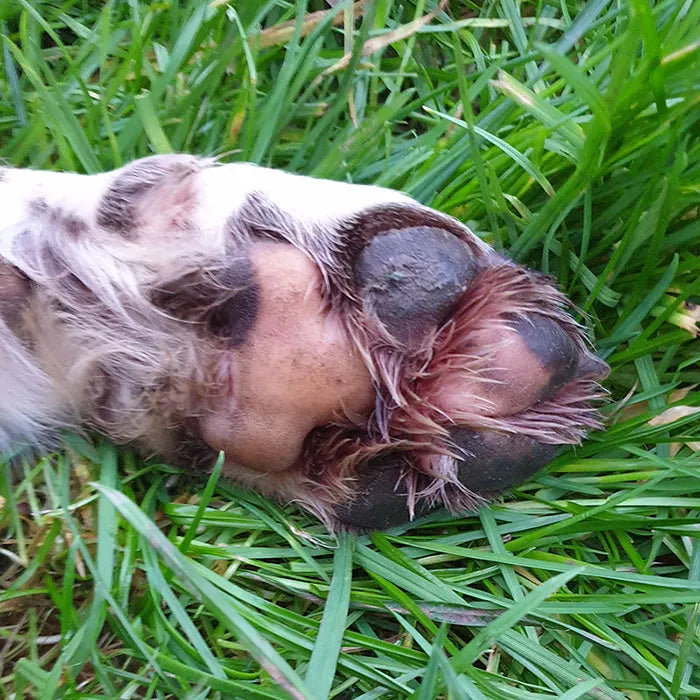Feclab Canine Yeast Dermatitis Test Kit
Feclab Canine Yeast Dermatitis Test Kit
Couldn't load pickup availability
Canine Yeast Dermatitis Test Kit
Yeast infections / dermatitis are a common problem in dogs. The main species of yeast that affects dogs is Malassezia, which can live happily on a healthy dog. The dogs immune system will usually keep yeast numbers in check however on occasions other conditions such as food allergies, illness affecting the immune system and hormonal conditions can cause the Malassezia to develop in larger numbers causing an imbalance; leading to an infection.
Yeast infections can also affect dogs that like to swim. In this case, the ears provide a perfect environment (moisture) for the yeast to flourish!
It is also common to see yeast infections in dogs where food allergies are present. This can also be the case for dogs that suffer with environmental allergies too. Anything that negatively impacts the skins ‘normal’ defence can make a yeast infection more likely.
Symptoms:
- Sore / Red irritated, itchy skin (which can occur anywhere on the dogs skin, including the tummy, skin folds, armpits, paws etc)
- Skin may be greasy or flaky
- Odour
- Brown discharge in the ears which may cause rubbing of their face
Yeast or mites?
A very good question! While some symptoms may be similar, you know your pet and symptoms such as an odour, associated with a yeast infection will be a good indication. You may have already started an elimination diet and therefore already suspect higher yeast levels. As with anything, sometimes, it is simply a process of elimination.
What we do:
Your samples will be examined under the microscope using the Impression Tape samples and by carrying out a smear test with your swab sample.
What will this test tell me?
This test is a non-invasive tool that can be used as a process of elimination where your dog is experiencing symptoms. If your dog is showing severe symptoms then you should contact your vet for advice and treatment options. Results from this test can be shared with your vet who (where applicable) will then be able to determine the best treatment options, appropriate for your dog.
Your vet may also wish to carry out additional testing to identify the root cause if an underlying condition is suspected.
Tip > Pet Insurance: You may be able to make a claim on your pet insurance for this test and ongoing treatment, should a positive result be identified. In this case, speaking to your veterinary practice and insurance company would be advisable.
What is included in my Kit?
- Instructions for use.
- 1 x Hygiene Swab.
- 4 x impression tape swabs.
- All Feclab kits contain instructions and free 1st class return postage, which can be popped in to a standard letter box.
Results will be emailed to you within 2 – 3 days of us receiving your sample.
Instructions for use
Swab Sample:
1. Using the swab provided, wipe the swab end around all the areas of concern.
2. Once taken, place the swab back in the tube and do the lid up (making sure it is tight).
3. Write your dogs’ name on the tube
4. Place your swab tube in the bubble wrap bag provided
Impression Tape:
Your kit contains 4 Tape Impressions.
1. Peel back the paper side, trying not to touch the sticky side of the tape.
2. On the area of concern, clear as much hair as possible and place the tape on to the area. Rub this with your finger so that it is pressed against the skin.
3. With your finger, rub over the top of the tape to ensure all of the tape touches the area of concern. Do this for each impression.
4. Once done, fold the impression tape in half, so that it sticks to itself.
5. Place your impression samples in to the small zip bag and seal.
Finally: Place your Impression samples, your swab sample and this leaflet into the pre-paid returns envelope and pop this in a standard letter box.
** You will receive your results within 2 – 3 days via email. Please keep an eye on your spam folder too. If you have not received your results within this time, please do contact us.
Ingredients
Ingredients
Contains 85% fresh meat, offal and bone.
British Chicken with Bone, British Beef Green Tripe, British Beef Kidney, British Beef Liver, Fresh Carrots, Fresh Butternut Squash, Fresh Broccoli, Fresh Green Curly Kale, Scottish Cold Water Salmon Oil, Organic Virgin Coconut Oil, Raw Sea Kelp Powder (Laminaria japonica), Bilberry Powder (Vaccinium Mytilus), Spirulina Powder (Spirulina platensis),? Whole Milled? Sesame Seeds, Wheat Germ Oil (natural vitamin E)
Feeding Guide
Feeding Guide
Adult Raw Feeding Guide
Adult dogs should be fed between 2-3% of their IDEAL bodyweight. If your dog needs to gain or lose weight, then work out the appropriate amount for what they should weigh, and this will assist with weight loss or weight gain as needed. This range given is also dependant on your dog’s activity levels.
Generally, an adult dog is classed as a dog 1 year and above, however larger breed dogs can continue to grow for up to 18 months to 2 years old so you should feed more, according to their growth rate and reduce the amount to 2-3% once they have finished growing.
2-3% of the ideal bodyweight. A range is given rather than a set amount so that depending on factors such as your dog’s activity levels or even just their own eating habits, you can add or reduce the amount within this range according to your dog’s individual needs. I usually advise owners to start with 2.5% and then you can adjust accordingly if needed.
Dogs ideal weight x 0.02 = 2% in grams per day
Dogs ideal weight x 0.03 = 3% in grams per day
Example Calculation:
For a 15kg adult dog of ideal weight the calculation would be:
15 x 0.025 (2.5%) = 0.375 (375g per day)
Puppy/Kitten Raw Feeding Guide
Puppies and kittens need a higher amount of protein as they grow, as protein is the component to developing new tissue within the body and also provides energy which they burn a lot of during the growth process and obviously because they tend to be particularly lively when younger! They should be fed according to their actual weight, so it’s important to weigh them regularly to ensure that they are getting the required amount as they grow.
7-10 weeks – 8-10%: Current weight x 0.08 to 0.1 = grams per day
10-16 weeks – 7-8%: Current weight x 0.07 to 0.08 = grams per day
16-20 weeks – 6-7%: Current weight x 0.06 to 0.07 = grams per day
20-24 weeks – 5-6%: Current weight x 0.05 to 0.06 = grams per day
24-36 weeks – 4-5%: Current weight x 0.04 to 0.05 = grams per day
36-56 weeks – 3-4%: Current weight x 0.03 to 0.04 = grams per day
Can drop to 2-3% after 52 weeks and follow Adult feeding guide if your dog has reached adult weight at this stage.
56-68 weeks – 2.5-3.5%: Current weight x 0.025 to 0.035 = grams per day
68+ weeks – 2-3% Current weight x 0.02 to 0.03 = grams per day
Example Calculation:
For a 12 week old puppy weighing 8kg the calculation range would be:
8 x 0.07 (7%) = 0.56 (560g per day)
8 x 0.08 (8%) = 0.64 (640g per day)
In this example I would suggest feeding midway of this range at 600g per day to allow for adjustment either side depending on their activity levels and eating habits.
Share


